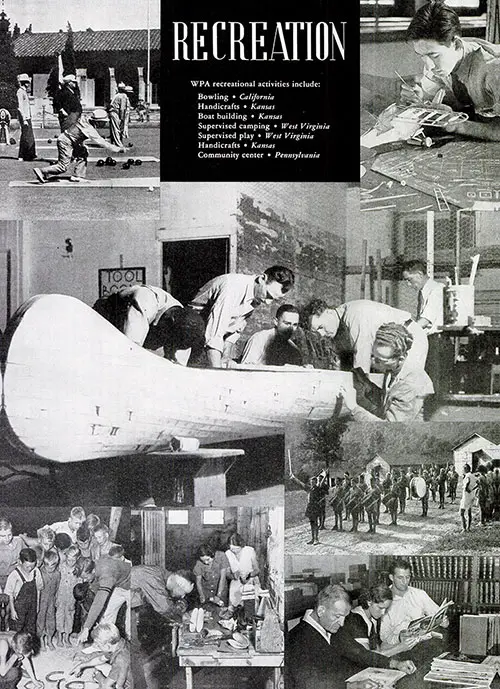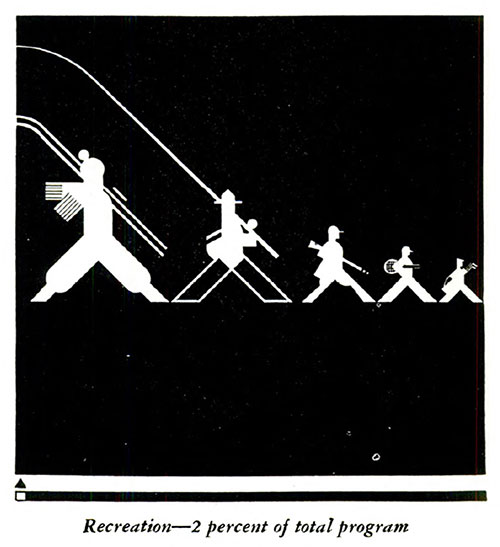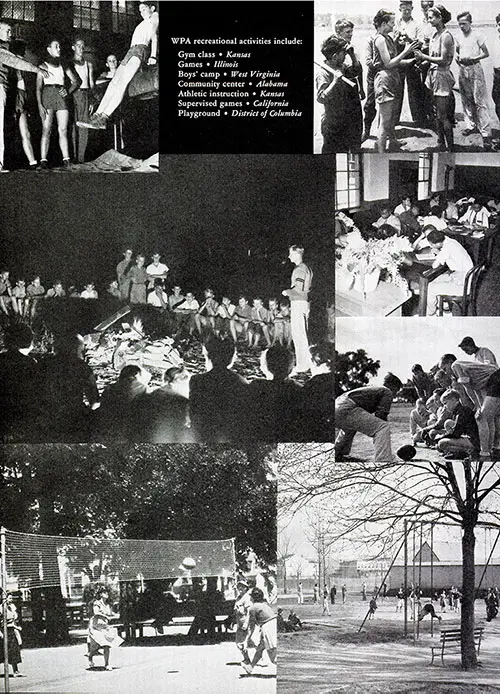🏛 How the WPA Transformed Public Recreation: Community Centers, Sports, & Arts Programs That Shaped America
📌 The WPA’s 1938 recreation programs trained over 34,000 leaders, established 15,000 community centers, and provided free public access to sports, arts, and cultural activities. Discover how these initiatives shaped modern municipal recreation.

Collage of WPA Recreational Activities That Includes Bowling (California), Handicrafts (Kansas), Boat Building (Kansas), Supervised Camping (West Virginia), Supervised Play (West Virginia), Handicrafts (Kansas), Community Center (Pennsylvania). Inventory: An Appraisal of Results of the Works Progress Administration, Washington, DC: US Government Printing Office, 1938. | GGA Image ID # 15255e9bba
🎭 WPA Recreational Activities - 1938
How the WPA Transformed Public Recreation and Enriched Communities
📖 The WPA’s 1938 report on recreational activities showcases how federal funding helped establish and expand public recreation programs across the United States. With over 34,000 trained recreation leaders and 15,000 community centers, this initiative provided structured leisure activities that promoted physical fitness, social engagement, and cultural enrichment.
For teachers, students, genealogists, and historians, this document provides:
✔️ A comprehensive look at how government-sponsored recreation shaped modern community programs.
✔️ Examples of how organized activities benefited both children and adults during economic hardship.
✔️ Insight into how public opinion on recreation shifted, leading to permanent programs.
✔️ Evidence of how WPA initiatives contributed to long-term municipal and state recreation policies.
📌 This report underscores the importance of structured recreation for mental and physical well-being, particularly during times of economic uncertainty.
More than 34,000 trained WPA recreation leaders are at work throughout the Nation aiding men, women, and children to spend their leisure time pleasurably and profitably. They have conducted, in whole or in part, more than 15,000 community centers.

Subject Matter Title Page for WPA Recreation Projects—2 Percent of Total Program. Inventory: An Appraisal of Results of the Works Progress Administration, Washington, DC: US Government Printing Office, 1938. | GGA Image ID # 1525f98679
With widespread unemployment and steadily shorter working hours among those who have jobs, officials of many communities saw the necessity during recent years for organized recreational activities which would provide constructive uses for leisure time.
As a result, WPA recreation projects were sponsored by local officials in practically every county of 47 States, the District of Columbia, and Hawaii. The recreation leaders employed on these projects, in the days before they lost their private jobs, were a cross section of the "white-collar" crafts—professional and technical workers, proprietors and managers, sales and office workers, or students without previous work experience.
Their education is well above average. More than 41 percent of them have gone to college, against a national average of 6.9 percent; more than 43 percent have gone to high school, as against a national average of 25.9 percent. Their average age is 32.8 years, and 57 percent of them are under 35.
They were chosen from the relief rolls because of their skills and education for leadership, and they have been trained for their WPA jobs in more than 45,000 instructional meetings held throughout the country during the past 2 years.
Colleges and universities have aided the training program with plant and personnel, and in many cases have given college credits for these courses. In 1935 there were only 2,606 recreation leaders employed full time by public agencies in the entire country.
Since that time over 2,000 WPA recreation workers are reported to have left the rolls to go into recreation work alone, while several thousand others have gone into allied fields by reason of their WPA training.
Example: In Decatur, 111., a tax levy for a permanent recreation program failed. Eighteen months later, after a successful WPA program, it carried every precinct.
Said Thomas Rickman, Jr., WPA's assistant State director for recreation, "It was a vote of approval for the program which has been carried on under the supervision and aid of the Works Progress Administration."
WPA recreation leaders have conducted programs, either alone or in cooperation with other agencies, in 15,288 community centers. In addition to operating these buildings, they have made use of other areas and buildings available in the communities, including playgrounds, schools, parks, picnic areas, camps, settlement houses, labor halls, swimming pools, outdoor theatres, band shells, athletic fields, auditoriums, gymnasiums, skating rinks, and ski trails.
In many communities, the WPA recreation program has complemented the WPA construction program, providing supervisory personnel for the operation of park facilities built by the WPA. Recreation activities include dramatics, swimming, dancing, baseball, music, puppetry, weaving, festivals, woodworking, pageants, metalcraft, camping, and hundreds of others specifically requested by the people of local communities.
As a part of the WPA's Nationwide inventory of its manifold activities, the extent to which the public participated in the emergency recreation program was checked, project by project, for one week. In that single week, the general public spent an aggregate of 16,320,211 hours participating in leisure time activities conducted by WPA recreation leaders.
Contrary to the idea that the program is merely one of play for children, it was found that 40 percent of the participation during this sample week was by adults. Twenty thousand citizens interested in recreation are working on 4,000 community councils which advise and represent the program in their local communities.
They have become active supporters of the program and have taken a large part in the promotion of permanent local public recreation programs. Often the council becomes the nucleus of a new Public Recreation Commission.
Evidence of the enlarged public interest and participation in organized recreation programs is contained in hundreds of letters from local officials to the WPA. Los Angeles' expanded program was "due in no small measure to the demonstration of well-organized recreation, largely made possible through the assistance rendered by WPA workers," according to Recreation Superintendent George Hjelte. Chicago "found the WPA recreation division of the greatest value," while Recreation Director Alfred Hughes of Tacoma said, "The WPA in this field of service has yielded 100 cents on the dollar."
The city of Cincinnati reports that the WPA recreation program "has rendered a magnificent service," while Supervisor George H. Bauer of the New Brunswick, N. J., Bureau of Recreation says, "As a result of the recreation division of the WPA, municipal recreation has made great strides forward, and has been introduced into practically every city of the State."

Collage of Additional WPA Recreational Activities Projects that Include Gym Class (Kansas), Games (Illinois), Boys' Camp (West Virginia), Community Center (Alabama), Athletic Instruction (Kansas), Supervised Games (California), Playground (District of Columbia). Inventory: An Appraisal of Results of the Works Progress Administration, Washington, DC: US Government Printing Office, 1938. | GGA Image ID # 152562716f
"Recreation," in Inventory: An Appraisal of Results of the Works Progress Administration, Washington, DC: US Government Printing Office, 1938, pp. 67-70.
Why This Document is Important
📜 Relevance for Different Audiences
✔ For Educators & Community Leaders
🔹 Demonstrates the long-term value of recreational programs for schools and communities.
🔹 Provides examples of public engagement in physical and artistic activities.
🔹 Showcases how training programs prepared recreation leaders for careers in public service.
✔ For Historians & Genealogists
🔹 Reveals how federal funding shaped local community centers, parks, and recreation facilities.
🔹 Documents how unemployment relief extended beyond manual labor into social and cultural development.
🔹 Provides records of locations where individuals may have worked or participated in WPA recreation programs.
✔ For Public Policy & Urban Planning Experts
🔹 Illustrates how federal programs influenced long-term urban planning decisions.
🔹 Demonstrates the economic impact of community recreation investments.
🔹 Explains the transition from temporary relief projects to permanent public recreation funding.
📌 This document provides crucial insights into how government-backed recreation programs transformed American communities.
::::: Most Engaging & Insightful Content :::::
🎭 The Rise of Organized Recreation Programs
✔ Why This is Fascinating:
🔹 Before the WPA, public recreation programs were limited in many cities.
🔹 The WPA expanded the number of recreation leaders from 2,600 in 1935 to over 34,000.
🔹 More than 15,000 community centers provided structured activities for people of all ages.
✔ Key Takeaway:
The WPA laid the foundation for modern municipal recreation departments, setting the standard for future programs.
📌 This section is vital for community organizers, urban planners, and recreation professionals.
⚾ Expanding Access to Sports & Outdoor Activities
✔ Why This is Fascinating:
🔹 Programs included baseball, swimming, supervised camping, and even skiing.
🔹 Outdoor theaters, band shells, athletic fields, and skating rinks were utilized for free public use.
🔹 Public parks and recreation centers constructed by the WPA were immediately put to use.
✔ Key Takeaway:
These programs gave millions of unemployed Americans access to structured and affordable leisure activities.
📌 This section is crucial for sports historians, park administrators, and fitness advocates.
🎭 Cultural & Artistic Programs Flourish
✔ Why This is Fascinating:
🔹 Recreation leaders taught music, dance, theater, and puppetry.
🔹 Festivals, pageants, and dramatic performances brought communities together.
🔹 Crafts like weaving, woodworking, and metalwork provided creative outlets.
✔ Key Takeaway:
The WPA not only encouraged physical fitness but also cultivated cultural appreciation.
📌 This section is essential for arts educators, cultural historians, and performing arts enthusiasts.
🏛 Public Engagement & Long-Term Policy Change
✔ Why This is Fascinating:
🔹 Citizens actively participated in WPA recreation councils, helping shape future policies.
🔹 In Decatur, Illinois, a recreation tax levy failed at first but passed after residents saw WPA programs in action.
🔹 Thousands of WPA-trained recreation workers found permanent jobs in public service.
✔ Key Takeaway:
The WPA transformed public attitudes toward recreation, leading to the creation of permanent municipal programs.
📌 This section is valuable for public policy experts, government officials, and social historians.
🖼 Noteworthy Images & Their Significance
🖼 🎭 "Collage of WPA Recreational Activities"
🔹 Depicts bowling, boat building, supervised camping, and handicrafts.
🔹 Shows the diversity of recreational activities available to the public.
🖼 ⚾ "Collage of Additional WPA Recreational Activities"
🔹 Highlights gym classes, supervised play, community centers, and playgrounds.
🔹 Demonstrates how WPA programs catered to both children and adults.
📌 These images visually capture the scope and impact of WPA recreation initiatives.
Bias & Perspective Considerations
✔ Government-Centric View:
🔹 The report highlights successes but does not:
🔹 Address any shortcomings or criticisms of WPA recreation programs.
🔹 Discuss potential opposition to government-funded leisure activities.
🔹 Examine whether all communities had equal access to resources.
✔ Limited Discussion of Funding & Sustainability
🔹 How were these programs funded after WPA support ended?
🔹 Did communities successfully transition to permanent recreation programs?
🔹 Were there concerns about federal involvement in local recreation?
📌 While the report emphasizes the positive impact of WPA recreation initiatives, a more comprehensive analysis would include long-term sustainability and community challenges.
Final Thoughts: Why This Report Matters
"WPA Recreational Activities - 1938" demonstrates how a federal program revolutionized public recreation in America. By employing thousands of recreation leaders and creating structured leisure programs, the WPA laid the foundation for today’s municipal parks and recreation departments.
📌 These programs not only provided employment but also enhanced public well-being, proving that government investment in recreation has lasting societal benefits.
💡 The WPA’s recreation initiative reminds us that public access to sports, arts, and cultural activities is essential for a healthy and thriving society. 🎭⚾🏛
